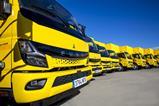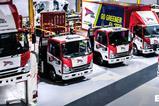Vicinity Motor’s new assembly plant in Washington State, with its substantial production capacity, aims to meet growing demand for low- and zero-emission vehicles in North America. The facility signals Vicinity Motor’s commitment to reducing carbon emissions while supporting local economies.

With orders amounting to over $150 million, including recent contracts with Lafarge Canada, Transdev, and Pioneer Auto Group, the new plant is equipped to assemble 850 low and zero-emission buses along with 6,250 Class 3 all-electric trucks on an annual basis.
The VMC1200, a medium-duty EV truck produced by Vicinity, features a 100 kWh power capacity, a range of up to 150 miles (240 kilometers) on a single charge, a 6,000-pound load capacity, a top speed of 65 mph, and an 8 kW onboard charger. The battery supply for Vicinity’s electric vehicles comes from Electrovaya, likely utilising NMC chemistry, while the drive system is reportedly provided by German SME Lion Smart.
Vicinity initially began production of the Class 3 truck in 2022 at its Aldergrove facility in British Columbia, Canada, before transitioning to the new Washington State factory.
Will Trainer, CEO of VMC stated, “With light- and medium-duty EV inventories across North America projected to top one million by 2030 and six million by 2040, I’m excited to see our business firing on all cylinders, and am immensely proud of the work our team has put into designing and building a world-class manufacturing facility.”
Aside from assembly, the Ferndale campus will also serve as a hub for pre-delivery inspections, research and development, and general technical and servicing work.
Although Vicinity Motor is headquartered in Aldergrove, BC, Canada, the new Washington campus is strategically located less than 20 miles south of the Canadian HQ. This proximity enhances access to nearby port, rail, and truck shipping and receiving infrastructure.
Vicinity Motor received a $300,000 economic development strategic reserve fund (SRF) grant and augmented its $30 million credit facility from the Royal Bank of Canada and Export Development Canada (EDC) with an additional $9 million working capital credit facility from EDC.


















